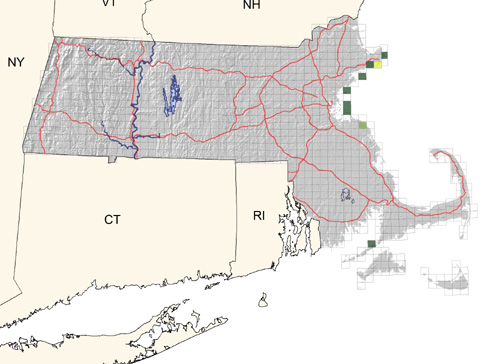Breeding Bird Atlases (BBA)
Find a Bird - BBA1
Breeding Bird Atlas 1 Species Accounts
Double-crested Cormorant
Phalacrocorax auritus
Egg Dates
April 5 to June
Number of Broods
one; may re-lay if first attempt fails.

Cormorants are now familiar sights along the coast and are seen increasingly in small numbers on inland lakes and rivers. The Double-crested Cormorant is a summer resident, replaced in winter by the Great Cormorant. Extirpated in the nineteenth century, Double-crested Cormorants returned to breed in Massachusetts by 1944 and have increased greatly, especially since about 1970. In 1977, 1,760 pairs nested at eleven sites. Subsequent increases have been substantial: in 1984 nearly 5,000 pairs nested at fifteen sites, and in the 1990s approximately 8,000 pairs nested at twenty-five sites. Breeding birds are numerous, apparently because of the presence of preferred nesting sites along the coast between Boston and Cape Ann, and in Buzzards Bay (Weepecket Islands). Nonbreeders are more widely distributed, especially during postbreeding dispersal. Traditional roosting sites are conspicuous, and some of these become breeding colonies after years of use. The increasing numbers of inland breeders are now as close as Lake Champlain so their appearance in Massachusetts may not be far off.
The migratory flights of cormorants can be striking, with many thousands of birds passing by day in a succession of untidy echelons, frequently numbering several hundred birds and sometimes thousands. Most of these movements occur over short periods: in spring many birds arrive in late March and early April, but continue into May; in fall the major departures are early in October, but some flights are reported in September through November. Coastal movements are common along the North Shore of Massachusetts Bay, but in fall many of the migrants fly overland from Boston southwest toward Narragansett Bay.
Breeding colonies vary in size from a handful of pairs to more than a thousand. The preferred sites along the Massachusetts coast are the flatter parts of small, undisturbed islands comprised of bedrock or eroding glacial deposits with boulders on the periphery. Sites with sand or soil are not preferred, and tree nests are very unusual (although reported for one year from House Island). On the Canadian coast and in the interior, many colonies are located in trees and elsewhere occasionally on shipwrecks or abandoned wharves. Thus, it seems likely that, although breeding birds are now absent from the sandy shores of Cape Cod, they may not remain so for long. (By 1994 small numbers nested at four sites [two constructed by people] on the Cape and Islands.)
Double-crested Cormorants are generally found near shallow waters, especially estuaries and bays, and almost never far offshore. They forage by diving from the surface and then swimming underwater with vigorous foot thrusts to catch a variety of fish. A typical dive lasts 30 seconds, and large or awkward prey may be swallowed at the surface. Feeding seems to take up only a minor part of the day, and cormorants spend much time loafing on rocks, pilings, or other nearby perches, often holding their wings out in a characteristic spread-wing posture. There has been some dispute about the function of this behavior, but it commonly is thought to serve in drying the wings. The feeding birds often commute in small parties from the roost (or colony) to feeding areas as far as 10 miles away, quite often inland.
In spring, the newly returned migrants speedily begin to build their bulky nests of seaweed, twigs, and a diverse array of flotsam and jetsam. The nests are generally lined with finer materials, but sometimes newly laid eggs are surrounded by no more than a ring of kelp or rockweed. Nest building may start on top of the remnants of previous years’ constructions and continue at least through incubation so that the results are substantial heaps consolidated by large quantities of guano. This last substance combines with abandoned fish and numbers of dead young to give cormorant colonies a powerful reek, detectable far downwind.
In the vicinity of the nest, cormorants exhibit striking social displays and emit more-or-less guttural grunts and croaks, but elsewhere (except during the early stages of courtship) they are generally silent and undemonstrative. Fighting is unusual so that the crowded colonies differ from those of gulls and terns where squabbling is conspicuous. The “double crests” that give the species its name are inconspicuous in eastern United States birds and are present only during the breeding season. Both parents share in nest building, incubation, and care of the young. The eggs are initially pale blue, but soon gain a dirty white appearance. Four is the most frequent clutch size, but three and five eggs are common. Hatching occurs about 26 days after laying, a little later for the earlier eggs in the clutch. For the first few days after hatching, the chicks are blind, naked, and helpless; then the shiny, nearly black skin is covered by a thick coat of black down. After three weeks or so, the young may wander within the colony, returning to the nest to be fed. They first fly at about six weeks, and it is thought that parental care ceases when the young are about ten weeks old. Cormorants are wary, and their colonies very subject to disturbance, which can lead to extensive depredations on eggs and small chicks by the ever-present gulls or sometimes crows. Visits to colonies are strongly discouraged because of disturbance created by human presence. Most Massachusetts birds winter along the coast from North Carolina to Florida, but small numbers linger north to New England, where they are regularly recorded on Christmas Bird Counts.
Map Legend and Data Summary
Atlas 1 data collected from 1975-1979


Note: locally abundant on rocky coastal islands; dramatic recent increase
Jeremy Hatch



